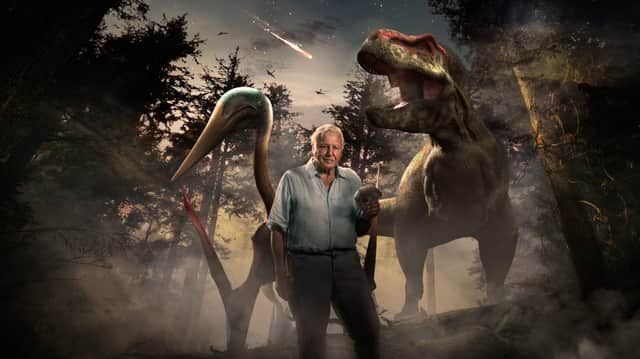Dinosaurs: The Final Day with David Attenborough


We’re not quite at the Jurassic Park point just yet but this new David Attenborough series does give us a greater understanding of the creatures and the catastrophic event that precipitated their extinction.
The programme uses palaeontologist Robert DePalma’s work as its main source. In 2012 DePalma was brought in as a graduate student to investigate a site named Tanis in southwestern North Dakota, United States, where he made some remarkable discoveries.
Advertisement
Hide AdAdvertisement
Hide AdThrough years of careful excavations, conducted in near-total secrecy, DePalma realised that a very specific set of freak circumstances allowed for the preservation of exquisite, moment-by-moment details of what happened when an asteroid bigger than Mount Everest struck late-Cretaceous Earth.
The unique consistency of the material at the site meant that animals and plants were preserved in three-dimensional detail, even standing upright in some instances, whereas under normal circumstances fossilised remains would have been flattened by the weight of the earth.
Now, veteran naturalist Attenborough and the BBC’s boffins have been able to use his findings to create a CGI representation of the late Cretaceous era, bringing it to life with a level of detail and accuracy never seen before.
They are then able to document, minute-by-minute, exactly what happened to this area of what is now known as Hell Creek.
Advertisement
Hide AdAdvertisement
Hide AdAmong the findings made at the site are intact feathers believed to have come from dinosaurs – lending strength to a theory that many of the creatures were plumed rather than having the leathery scales we imagine when we think of them. And while the fictional Jurassic Park relied on amber to recreate their genetically modified dinosaurs, here in the real world amber is found to hold some remarkable clues as to what actually happened the moment the mass extinction event began.
Attenborough says: “Dinosaurs were among nature’s most extraordinary creatures, dominating the planet for over 150 million years before they became extinct.
“Tanis could be a place where the remains can give us an unprecedented window into the lives of the very last dinosaurs, and a minute-by-minute picture of what happened when the asteroid hit.”
Meanwhile Jack Bootle, the Head of Commissioning for Science and Natural History, says: “BBC Studios Science Unit has brilliantly combined cutting-edge CGI with the very latest science to depict, in meticulous detail, what happened on the day of the asteroid strike.
“I’ve longed to know exactly how the dinosaurs died ever since I was a little boy. Now, finally, I can see it.”
As, of course, can we.